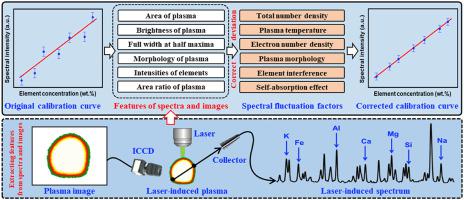Analytica Chimica Acta ( IF 6.2 ) Pub Date : 2022-11-04 , DOI: 10.1016/j.aca.2022.340552 Deng Zhang 1 , Junfei Nie 1 , Honghua Ma 1 , Xuechen Niu 1 , Shengqun Shi 1 , Feng Chen 1 , Lianbo Guo 1 , Xiaoyuan Ji 2

|
Spectral fluctuation is one of the main obstacles affecting the further development of LIBS, and it is also the current research hotspot and difficulty. To meet the requirements of industrial monitoring, a novel method named plasma image-spectrum fusion laser induced breakdown spectroscopy (PISF-LIBS) was proposed to correct the spectral fluctuation and improve the quantitative accuracy. In this method, by systematically analyzing the spectral radiation model, six main factors affecting the spectral stability were obtained. Further, the standard spectrum in the ideal plasma state which is not affected by these six factors was calculated, and the deviation from the actual spectrum was obtained. According to the above analysis, the calculated deviation was mainly affected by these six factors and can be estimated through them. Therefore, this study creatively proposed to use the effective information in the plasma images and spectra to indirectly characterize the deviation, so as to realize the correction of spectral fluctuation. To verify the wide applicability of PISF-LIBS in experimental conditions, the LIBS spectra of aluminum alloy obtained under four different experimental conditions were used. After PISF-LIBS correction, the R2 increased to more than 0.974, and the RMSE, MAPE and RSD of the prediction set decreased by 44.789%, 47.854% and 51.687% on average. To further verify the wide applicability of PISF-LIBS in experimental samples, alloy steel samples and pressed samples were also used. For alloy steel samples, after PISF-LIBS correction, the R2 increased to more than 0.996, and the RMSE, MAPE and RSD of the prediction set decreased by 48.337%, 52.856% and 25.819% evenly. For pressed samples, the R2 increased over 0.992, and the RMSE, MAPE and RSD of the prediction set decreased by 61.493%, 61.080% and 39.945% averagely. The experimental results prove the effectiveness and wide applicability of PISF-LIBS in spectral fluctuation correction.
中文翻译:

激光诱导击穿光谱中基于辐射模型的提高光谱稳定性的等离子体图像-光谱融合校正策略
光谱波动是影响LIBS进一步发展的主要障碍之一,也是当前的研究热点和难点。为了满足工业监测的要求,提出了一种新的等离子体图像-光谱融合激光诱导击穿光谱(PISF-LIBS)方法来校正光谱波动,提高定量精度。该方法通过系统地分析光谱辐射模型,得出影响光谱稳定性的六个主要因素。进一步计算不受这六个因素影响的理想等离子体状态下的标准光谱,并获得与实际光谱的偏差。根据以上分析,计算出的偏差主要受这六个因素的影响,可以通过它们进行估算。所以,本研究创造性地提出利用等离子体图像和光谱中的有效信息间接表征偏差,从而实现光谱波动的校正。为了验证PISF-LIBS在实验条件下的广泛适用性,使用了四种不同实验条件下获得的铝合金LIBS光谱。PISF-LIBS校正后,R2增加到0.974以上,预测集的RMSE、MAPE和RSD平均下降了44.789%、47.854%和51.687%。为了进一步验证 PISF-LIBS 在实验样品中的广泛适用性,还使用了合金钢样品和压制样品。对于合金钢样品,经过PISF-LIBS校正后,R 2增加到0.996以上,预测集的RMSE、MAPE和RSD均匀下降48.337%、52.856%和25.819%。对于压制样品,R 2增加了0.992以上,预测集的RMSE、MAPE和RSD平均下降了61.493%、61.080%和39.945%。实验结果证明了PISF-LIBS在光谱波动校正方面的有效性和广泛适用性。


























 京公网安备 11010802027423号
京公网安备 11010802027423号